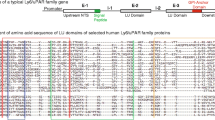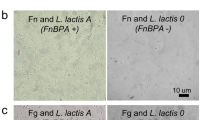Abstract
The fibronectin produced by clonal murine-human hybrid cell lines containing various complements of human chromosomes was measured. Human and murine fibronectins were assayed by specific immunoassay, and the production of human fibronectin was correlated with karyology and isozyme markers for specific human chromosomes. The data show a 100% concordance between the expression of human fibronectin and glutathione reductase, a marker for human chromosome 8, indicating that chromosome 8 codes for the fibronectin polypeptide.
Similar content being viewed by others
References
Dessau, W., Sasse, J., Timpl, R., and von der Mark, K. (1978). Role of fibronectin and collagen types I and II in chondrocyte differentiation in vitro. Ann. N.Y. Acad. Sci. 312404–405.
Donald, L. J., and Hamerton, J. L. (1978). A summary of the human gene map, 1973–1977. Cytogenet. Cell Genet. 225–11.
Engvall, E., and Ruoslahti, E. (1977). Binding of the soluble form of fibroblast surface protein (fibronectin) to collagen. Int. J. Cancer 201–17.
Friend, K. K., Dorman, B. P., Kucherlapati, R. S., and Ruddle, F. H. (1976). Detection of interspecific translocations in mouse-human hybrids by alkaline Giemsa straining. Exp. Cell Res. 9931–36.
Furcht, L. T., Mosher, D. F., Wendelschafer-Crabb, G. (1978). Immunocytochemical localization of fibronectin (LETS proteins) on the surface of L 6 myoblasts. Cell 13263–271.
Furthmayr, H., and Timpl, R. (1971). Characterization of collagen peptides by sodium dodecyl sulfate-polyacrylamide electrophoresis. Anal. Biochem. 41510–516.
Hynes, R. O. (1976). Cell surface protein and malignant transformation. Biochim. Biophys. Acta 45873–107.
Kessler, W. S. (1975). Rapid isolation of antigens from cells with a staphyloccocal protein A—antibody adsorbant. J. Immunol. 1151617–1674.
Klebe, R. J., Che, T. R., and Ruddle, F. H. (1970). Controlled production of proliferating somatic cell hybrids. J. Cell Biol. 4574–82.
Klebe, R. J. (1974). Isolation of a collagen-dependent cell attachment factor. Nature 250248–251.
Laemmli, V. R. (1970). Cleavage of structural proteins during the assembly of the head of bacteriophage T4. Nature 227680–685.
McKusick, V. A., and Ruddle, F. H. (1977). The status of the gene map of the human chromosomes. Science 196390–405.
Miggiano, V., Vabholy, M., and Bodmer, W. (1969). In Heterospecific Genome Interaction, The Wistar Institute Symposium Monograph, No. 9, pp. 61–76.
Mosher, D. F., Schad, P. E., and Kleinman, H. K. (1979). Cross-linking of fibronectin to collagen by blood coagulation factor XIIIa. J. Clin. Invest. 64781–797.
Nichols, E. A., and Ruddle, F. H. (1973). A review of enzyme polymorphism, linkage and electrophoretic conditions for mouse and somatic cell hybrids in starch gels. J. Histochem. Cytochem. 211066–1081.
Owerbach, D., Doyle, D., and Shows, T. B. (1978). Genetics of the large, external, transformation-sensitive (LETS) protein: assignment of a gene coding for expression of LETS to human chromosome 8. Proc. Natl. Acad. Sci. U.S.A. 755640–5644.
Rennard, S. I., Berg, R. Martin, G. R., Foidart, J. M., and Robey, P. G. (1980). Enzyme-linked immunoassay for connective tissue components. Anal. Biochem. 104205–214.
Rodbard, D. (1971). Statistical aspects of radioimmunoassay. In Daughaday, W. D., and Odell, W. A. (eds.), Competitive Protein Binding Assays Lippincott, Philadelphia, pp. 204–259.
Ruoslahti, E., and Vaheri, A. (1975). Interaction of soluble fibroblast surface antigen with fibrinogen and fibrin; identity with cold insoluble globulin of human plasma. J. Exp. Med. 141497–501.
SundarRaj, C. V., Church, R. L., Klobutcher, L. A., and Ruddle, F. H. (1977). Genetics of the connective tissue proteins: assignment of gene for human type I procollagen to chromosome 17 by analysis of cell hybrids and micro cell hybrids. Proc. Natl. Acad. Sci. U.S.A. 744444–4448.
Vaheri, A., and Ruoslahti, E. (1975). Fibroblast surface antigen produced but not retained by virus transformed human cells. J. Exp. Med. 142530–535.
Yamada, K. A., and Olden, K. (1978). Fibronectins-adhesive glycoproteins of cell surface and blood. Nature 274179–184.
Yolken, R. H., Kim, H. W., Clem, T., Wyatt, R. G., Kalica, A. R., Chanock, R. M., and Kapikian, A. F. (1977). Enzyme-linked immunoassay (ELISA) for detection of human reovirus-like agent of infantile gastroenteritis. Lancet 2263–266.
Author information
Authors and Affiliations
Rights and permissions
About this article
Cite this article
Rennard, S.I., Church, R.L., Rohrbach, D.H. et al. Localization of the human fibronectin (FN) gene on chromosome 8 by a specific enzyme immunoassay. Biochem Genet 19, 551–566 (1981). https://doi.org/10.1007/BF00484626
Received:
Revised:
Issue Date:
DOI: https://doi.org/10.1007/BF00484626




